| Maintenance Service Interval | Maintenance Procedure |
|---|---|
| Before each use or daily |
|
Introduction
This machine is a ride-on, rotary-blade machine intended to be used by professional, hired operators in commercial applications. It is primarily designed for cutting grass on well-maintained lawns in parks, sports fields, and on commercial grounds. It is not designed for cutting brush or mowing grass and other growth alongside highways, or for agricultural uses.
Read this information carefully to learn how to operate and maintain your product properly and to avoid injury and product damage. You are responsible for operating the product properly and safely.
You may contact Toro directly at www.Toro.com for product safety and operation training materials, accessory information, help finding a dealer, or to register your product.
Whenever you need service, genuine Toro parts, or additional information, contact an Authorized Service Dealer or Toro Customer Service and have the model and serial numbers of your product ready. Figure 1 identifies the location of the model and serial numbers on the product. Write the numbers in the space provided.
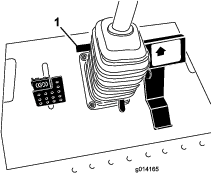
This manual identifies potential hazards and has safety messages identified by the safety-alert symbol (Figure 2), which signals a hazard that may cause serious injury or death if you do not follow the recommended precautions.

This manual also uses 2 words to highlight information. Important calls attention to special mechanical information and Note emphasizes general information worthy of special attention.
Warning
Diesel engine exhaust and some of its constituents are known to the State of California to cause cancer, birth defects, and other reproductive harm.
Genuine Toro spark arresters are approved by the USDA Forestry Service.
It is a violation of California Public Resource Code Section 4442 or 4443 to use or operate the engine on any forest-covered, brush-covered, or grass-covered land unless the engine is equipped with a spark arrester, as defined in Section 4442, maintained in effective working order or the engine is constructed, equipped, and maintained for the prevention of fire.
Safety
This machine has been designed in accordance with EN ISO 5395:2013 and ANSI B71.4-2012.
Improper use or maintenance by the operator or owner can result in injury. To reduce the potential for injury, comply with these safety instructions and always pay attention to the safety alert symbol, which means Caution, Warning, or Danger—personal safety instruction. Failure to comply with the instruction may result in personal injury or death.
General Safety
This product is capable of amputating hands and feet and of throwing objects. Always follow all safety instructions to avoid serious personal injury.
Using this product for purposes other than its intended use could prove dangerous to you and bystanders.
-
Read and understand the contents of this Operator’s Manual before you start the engine. Ensure that everyone using this product knows how to use it and understands the warnings.
-
Do not put your hands or feet near moving components of the machine.
-
Do not operate the machine without all guards and other safety protective devices in place and working on the machine.
-
Keep clear of any discharge opening. Keep bystanders a safe distance from the machine.
-
Keep children out of the operating area. Never allow children to operate the machine.
-
Stop the machine and shut off the engine before servicing, fueling, or unclogging the machine.
Improperly using or maintaining the machine can result in injury. To reduce the potential for injury, comply with these safety instructions and always pay attention to the safety-alert symbol, which means Caution, Warning, or Danger—personal safety instruction. Failure to comply with these instructions may result in personal injury or death.
You can find additional items of safety information in their respective sections throughout this manual.
Safety and Instructional Decals
 |
Safety decals and instructions are easily visible to the operator and are located near any area of potential danger. Replace any decal that is damaged or lost. |


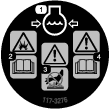
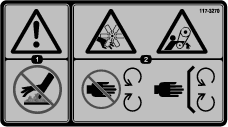




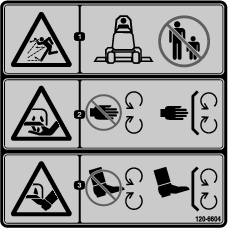



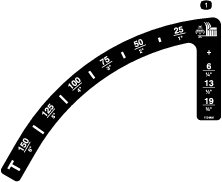
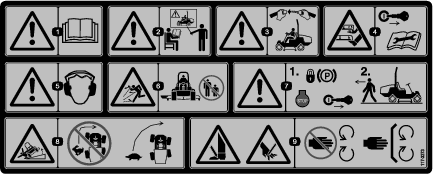


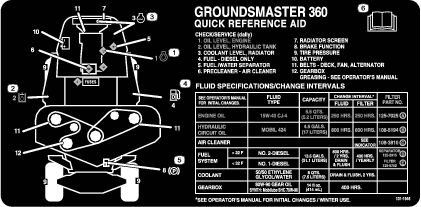

Setup
Adjusting the ROPS
-
Remove the hairpin cotter pins and the pins from the roll bar (Figure 3).
-
Raise the roll bar to the upright position and install the 2 pins and secure them with the hairpin cotter pins (Figure 3).
Note: If you must lower the roll bar, push the bar forward to relieve pressure on the pins, remove the pins, lower the bar slowly, and secure it with the pins so that it does not damage the hood.
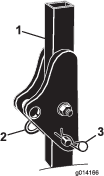
Checking the Tire Pressure
The tires are overinflated for shipping. Therefore, release some of the air to reduce the pressure. Check the tire pressure; refer to Checking the Tire Pressure.
Checking the Fluid Levels
-
Check the level of the hydraulic fluid before starting the engine; refer to Checking the Hydraulic System.
-
Check the level of the engine oil before starting the engine; refer toChecking the Engine-Oil Level.
-
Check the cooling system before starting the engine; refer to Checking the Cooling System .
Product Overview
Become familiar with all the controls before you start the engine and operate the machine.
Traction Pedal
The traction pedal (Figure 4) controls the forward and reverse operation. Press the top of the pedal to move forward and the bottom to move rearward. Ground speed depends on how far you press the pedal. For no load, maximum ground speed, fully press the pedal while the throttle is in the FAST position.
To stop the machine, reduce your foot pressure on the traction pedal and allow the pedal to return to the CENTER position.
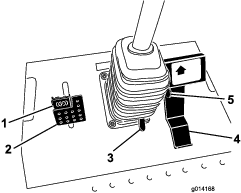
Mow-Speed Limiter
The mow-speed limiter (Figure 4) limits the traction speed of the machine when you flip it forward.
Brake Pedal
Use the brake pedal in conjunction with the brake-pedal latch to engage and disengage the parking brake (Figure 4). To stop the machine, release the traction pedal and allow it to return to the CENTER position. The brake can assist in stopping in an emergency situation.
Parking Brake
To engage the parking brake, push down on the brake pedal and press the top forward to latch it (Figure 4). To release the parking brake, press the brake pedal until the parking-brake latch retracts.
Tilt-Steering Pedal
To tilt the steering wheel toward you, press the foot pedal down and pull the steering tower toward you to the most comfortable position and then release the pedal (Figure 4).
Engine-Speed Switch
The engine-speed switch (Figure 5) has 2 modes to change the engine speed. By momentarily tapping the switch, you can increase or decrease the engine speed in increments of 100 rpm. Press and hold the switch to set the engine speed directly to high or low idle, depending on which end of the switch you press.
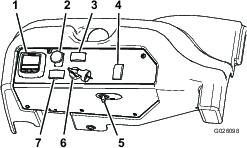
InfoCenter
The InfoCenter LCD display shows the operating status, various diagnostics, and other information about the machine (Figure 5).
Ignition Switch
The ignition switch has 3 positions: Off, On/Preheat, and Start (Figure 5).
Power Take-Off (PTO) Switch
The power take-off (PTO) switch starts and stops the mower blades (Figure 5).
Steering Selector Switch
Press the steering selector switch to the rear to engage 4-wheel steering and forward to return to 2-wheel steering (Figure 5).
Power Point
The power point is a 12-volt power supply for electronic devices (Figure 5).
Important: If the mower deck shuts down and the InfoCenter temperature-warning icon is on, push the PTO knob down, drive to a safe flat area, move the throttle lever to the SLOW position, allow the traction pedal to move to the NEUTRAL position, and set the parking brake. Allow the engine to idle for several minutes while it cools to a safe level. Shut off the engine and check the cooling system; refer to Checking the Cooling System .
Fuel Gauge
The fuel gauge (Figure 6) indicates the fuel level remaining in the fuel tank.
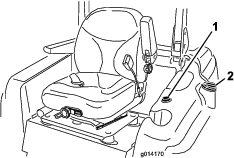
Using the InfoCenter LCD Display
The InfoCenter LCD display shows information about your machine, such as the operating status, various diagnostics, and other information about the machine (Figure 7). There is a splash screen and main information screen of the InfoCenter. You can switch between the splash screen and main information screen at any time by pressing any of the InfoCenter buttons and then selecting the appropriate directional arrow.
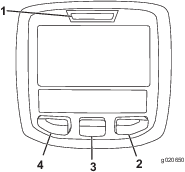
-
Left button, menu access/back button—press this button to access the InfoCenter menus. You can use it to back out of any menu that you are currently using.
-
Middle button—use this button to scroll down menus.
-
Right button—use this button to open a menu where a right arrow indicates additional content.
Note: The purpose of each button may change depending on what is required at the time. Each button is labeled with an icon displaying its current function.
| SERVICE DUE | Indicates when scheduled service should be performed |
 | Engine rpm/status—indicates the engine rpm |
 | Hour meter |
 | Info icon |
 | Fast |
 | Slow |
 | Stationary regeneration required |
 | Glow plugs are active |
 | AC |
 | 2-wheel steer |
 | 4-wheel steer |
 | Operator must sit in seat |
 | Parking brake indicator—indicates when the parking brake is set |
 | Coolant Temperature-indicates the engine coolant temperature in either °C or °F |
 | Temperature (hot) |
 | PTO is engaged |
 | Denied or not allowed |
 | Engine start |
 | Stop or shutdown |
 | Engine |
 | Key switch |
 | PIN code |
 | CAN bus |
 | InfoCenter |
 | Bad or failed |
 | Bulb |
 | Output of TEC controller or control wire in harness |
 | Switch |
 | Operator must release switch |
 | Operator should change to indicated state |
| Symbols are often combined to form sentences. Some examples are shown below | |
 | Operator should put machine in Neutral |
 | Engine start denied |
 | Engine shutdown |
 | Engine coolant too hot |
 | DPF ash accumulation notification. Refer to Servicing the Diesel-Oxidation Catalyst (DOC) and the Soot Filter for details. |
 | Sit down or engage parking brake |
Using the Menus
To access the InfoCenter menu system, press the menu access button while at the main screen. This brings you to the main menu. Refer to the following tables for a synopsis of the options available from the menus:
| Main Menu | |
| Menu Item | Description |
| Faults | The Faults menu contains a list of the recent machine faults. Refer to the Service Manual or your Authorized Toro Distributor for more information on the Faults menu and the information contained there. |
| Service | The Service menu contains information on the machine such as hours of use counters and other similar numbers. |
| Diagnostics | The Diagnostics menu displays the state of each machine switch, sensor and control output. You can use this to troubleshoot certain issues as it will quickly tell you which machine controls are on and which are off. |
| Settings | The Settings menu allows you to customize and modify configuration variables on the InfoCenter display. |
| About | The About menu lists the model number, serial number, and software version of your machine. |
| Service | |
| Menu Item | Description |
| Hours | Lists the total number of hours that the machine, engine, and PTO have been on, as well as the number of hours the machine has been transported and service due |
| Counts | Lists numerous counts the machine has experienced |
| Diagnostics | |
| Menu Item | Description |
| PTO | Indicates the inputs, qualifiers, and outputs for enabling the PTO circuit |
| Engine Run | Indicates the inputs, qualifiers, and outputs for starting the engine |
| Decks | Indicates the inputs, qualifiers, and outputs for lifting and lowering the deck |
| Steer Mode | Indicates the inputs, qualifiers, and outputs for switching between 2-wheel steer and 4-wheel steer |
| Machine Input | Indicates the state of other machine inputs such as accessories and A/C clutch |
| Settings | |
| Menu Item | Description |
| Units | Controls the units used on the InfoCenter; The menu choices are English or Metric. |
| Language | Controls the language used on the InfoCenter* |
| LCD Backlight | Controls the brightness of the LCD display |
| LCD Contrast | Controls the contrast of the LCD display |
| Protected Menus | Allows a person authorized by your company with the PIN code to access protected menus. |
| Auto Idle | Controls the amount of time allowed before returning the engine to low idle when the machine is stationary |
Only operator-faced text is translated. Faults, Service, and Diagnostics screens are service-faced. The titles are in the selected language, but the menu items are in English.
| About | |
| Menu Item | Description |
| Model | Lists the model number of the machine |
| SN | Lists the serial number of the machine |
| Machine Controller Revision | Lists the software revision of the master controller |
| InfoCenter Revision | Lists the software revision of the InfoCenter |
| CAN Bus | Lists the machine communication bus status |
Protected Menus
There are 2 operating configuration settings that are adjustable within the Settings Menu of the InfoCenter: Auto Idle time delay and Stationary Regeneration. You can lock these settings by using the Protected Menu. Refer to Diesel Particulate Filter Regeneration.
Accessing Protected Menus
Note: The factory default PIN code for you machine is either 0000 or 1234.If you changed the PIN code and forgot the code, contact your Authorized Toro Distributor for assistance.
-
From the MAIN MENU, use the center button to scroll down to the SETTINGS MENU and press the right button (Figure 8).
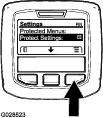
-
In the SETTINGS MENU, use the center button to scroll down to the PROTECTED MENU and press the right button (Figure 9A).
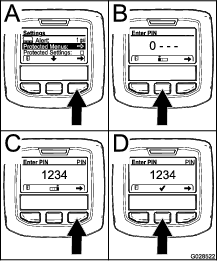
-
To enter the PIN code, press the center button until the correct first digit appears, then press the right button to move on to the next digit (Figure 9B and Figure 9C). Repeat this step until the last digit is entered and press the right button once more.
-
Press the middle button to enter the PIN code (Figure 9D).
Wait until the red indicator light of the InfoCenter illuminates.
Note: If the InfoCenter accepts the PIN code and the protected menu is unlocked, the word “PIN” displays in the upper right corner of the screen.
Note: Rotate the key switch to the OFF position and then to the ON position locks the protected menu.
You have the ability to view and change the settings in the Protected Menu. Once you access the Protected Menu, scroll down to Protect Settings option. Use the right button to change the setting. Setting the Protect Settings to OFF allows you to view and change the settings in the Protected Menu without entering the PIN code. Setting the Protect Settings to ON hides the protected options and requires you to enter the PIN code to change the setting in the Protected Menu. After you set the PIN code, rotate the key switch OFF and back to the ON position to enable and save this feature.
Setting the Auto Idle
-
In the Settings Menu, scroll down to Auto Idle.
-
Press the right button to change the Auto Idle time between OFF, 8S, 10S, 15S, 20S, and 30S.
Note: Specifications and design are subject to change without notice.
| Length | 241.3 cm (95 inches) |
| Width (rear wheels) | 147.3 cm (58 inches) |
| Height (with roll bar up) | 144.8 cm (78 inches) |
| Height (with roll bar down) | 137.2 cm (54 inches) |
| Mower deck | Weight |
| No mower deck | 1,152 kg (2,540 lb) |
| 72 inch side discharge mower deck | 1,363 kg (3,004 lb) |
| 60 inch side discharge mower deck | 1,337 kg (2,948 lb) |
| 72 inch base mower deck | 1,341 kg (2,956 lb) |
| 62 inch base mower deck | 1,324 kg (2,918 lb) |
| 100 inch rear discharge mower deck | 1,510 kg (3,330 lb) |
Attachments/Accessories
A selection of Toro approved attachments and accessories is available for use with the machine to enhance and expand its capabilities. Contact your Authorized Service Dealer or Distributor or go to www.Toro.com for a list of all approved attachments and accessories.
Operation
Note: Determine the left and right sides of the machine from the normal operating position.
Before Operation
Before Operation Safety
General Safety
-
Never allow children or untrained people to operate or service the machine. Local regulations may restrict the age of the operator. The owner is responsible for training all operators and mechanics.
-
Become familiar with the safe operation of the equipment, operator controls, and safety signs. Know how to stop the machine and engine quickly.
-
Check that all safety devices are attached and functioning properly. This includes, but is not limited to, operator-presence controls; safety switches and shields; the rollover protection system (ROPS); attachments; and brakes. Do not operate the machine unless all safety devices are in position and functioning as intended by the manufacturer.
-
Always inspect the machine to ensure that the blades, blade bolts, and cutting assembly are not worn or damaged. Replace worn or damaged blades and bolts in sets to preserve balance.
-
Inspect the area where you will use the machine and remove all objects that the machine could potentially throw.
-
Evaluate the terrain to determine the appropriate equipment and any attachments or accessories required to operate the machine properly and safely.
Fuel Safety
Danger
In certain conditions, fuel is extremely flammable and highly explosive. A fire or explosion from fuel can burn you and others and can damage property.
-
Fill the fuel tank outdoors, in an open area, when the engine is cold. Wipe up any fuel that spills.
-
Never fill the fuel tank inside an enclosed trailer.
-
Never smoke when handling fuel, and stay away from an open flame or where fuel fumes may be ignited by a spark.
-
Store fuel in an approved container and keep it out of the reach of children. Never buy more than a 180-day supply of fuel.
-
Do not operate the machine without the entire exhaust system in place and in proper working condition.
Warning
Fuel is harmful or fatal if swallowed. Long-term exposure to vapors can cause serious injury and illness.
-
Avoid prolonged breathing of vapors.
-
Keep your hands and face away from the nozzle and the fuel-tank opening.
-
Keep fuel away from your eyes and skin.
-
Use only an approved fuel container.
-
Never remove the fuel cap or add fuel to the fuel tank while the engine is running.
-
Never fill containers inside a vehicle or on a truck or trailer bed with a plastic liner. Always place containers on the ground and away from your vehicle before filling.
-
Remove the equipment from the truck or trailer and add fuel to it while it is on the ground. If this is not possible, then add fuel using a portable container rather than from a fuel-dispenser nozzle.
-
Keep the fuel-dispenser nozzle in contact with the rim of the fuel tank or container opening at all times until fueling is complete. Do not use a nozzle lock-open device.
-
If you spill fuel on your clothing, change your clothing immediately.
-
Fill the fuel tank until the fuel level is 25 mm (1 inch) below the bottom of the filler neck. Do not overfill the fuel tank. Replace the fuel-tank cap and tighten it securely.
Checking the Engine-Oil Level
Before you start the engine and use the machine, check the oil level in the engine crankcase; refer to Checking the Engine-Oil Level.
Checking the Cooling System
Before you start the engine and use the machine, check the cooling system; refer to Checking the Cooling System .
Checking the Hydraulic System
Before you start the engine and use the machine, check the hydraulic system; refer to Checking the Hydraulic System.
Filling the Fuel Tank
Fuel Tank Capacity
Fuel tank capacity: 51.1 L (13.5 US gallons)
Fuel Specification
Important: Use only ultra-low sulphur diesel fuel. Fuel with higher rates of sulfur degrades the diesel oxidation catalyst (DOC), which causes operational problems and shortens the service life of engine components.Failure to observe the following cautions may damage the engine.
-
Never use kerosene or gasoline instead of diesel fuel.
-
Never mix kerosene or used engine oil with the diesel fuel.
-
Never keep fuel in containers with zinc plating on the inside.
-
Do not use fuel additives.
Petroleum Diesel
Cetane rating: 45 or higher
Sulfur content: Ultra-low sulfur (<15 ppm)
| Diesel fuel specification | Location |
| ASTM D975 | USA |
| No. 1-D S15 | |
| No. 2-D S15 | |
| EN 590 | European Union |
| ISO 8217 DMX | International |
| JIS K2204 Grade No. 2 | Japan |
| KSM-2610 | Korea |
-
Use only clean, fresh diesel fuel or biodiesel fuels.
-
Purchase fuel in quantities that can be used within 180 days to ensure fuel freshness.
Use summer-grade diesel fuel (No. 2-D) at temperatures above -7°C (20°F) and winter-grade fuel (No. 1-D or No. 1-D/2-D blend) below that temperature.
Note: Use of winter-grade fuel at lower temperatures provides lower flash point and cold flow characteristics which eases starting and reduces fuel filter plugging.Using summer-grade fuel above -7°C (20°F) contributes toward longer fuel pump life and increased power compared to winter-grade fuel.
Biodiesel
This machine can also use a biodiesel blended fuel of up to B20 (20% biodiesel, 80% petroleum diesel).
Sulfur content: Ultra-low sulfur (<15 ppm)
Biodiesel fuel specification: ASTM D6751 or EN14214
Blended fuel specification: ASTM D975, EN590, or JIS K2204
Important: The petroleum diesel portion must be ultra-low sulfur.
Observe the following precautions:
-
Biodiesel blends may damage painted surfaces.
-
Use B5 (biodiesel content of 5%) or lesser blends in cold weather.
-
Monitor seals, hoses, gaskets in contact with fuel as they may be degraded over time.
-
Fuel filter plugging may be expected for a time after converting to biodiesel blends.
-
Contact your Authorized Toro Distributor if you wish for more information on biodiesel.
Adding Fuel
-
Park the machine on a level surface.
-
Shut off the engine and set the parking brake.
-
Clean around the fuel tank cap and remove the cap (Figure 10).

Important: Do not open the fuel tank when parked on a hill. The fuel could spill out.
-
Add fuel to the fuel tank, until the level is even with the bottom of the filler neck. Do not over fill the fuel tank.
-
Install the fuel tank cap and secure. Wipe up any fuel that may have spilled.
Note: If possible, fill the fuel tank after each use. This will minimize possible buildup of condensation inside the fuel tank.
Using the Rollover Protection System (ROPS)
-
Keep the roll bar in the raised and LOCKED position and use the seat belt when operating the machine.
-
Be certain that you can release the seat belt quickly in the event of an emergency.
-
Be aware there is no rollover protection when the roll bar is down.
-
Check the area to be mowed and never fold the ROPS in areas where there are slopes, drop-offs or water.
-
Lower the rollbar only when absolutely necessary. Do not wear the seat belt with the roll bar folded down.
-
Check carefully for overhead clearances (such as branches, doorways, or electrical wires) before driving under any objects and do not contact them.
Warning
To avoid injury or death from rollover: keep the roll bar in the raised locked position and use the seat belt.
Ensure that the seat plate is secured with the seat latch.
Warning
There is no rollover protection when the roll bar is in the DOWN position.
-
Drive slowly and carefully.
-
Raise the roll bar as soon as clearance permits.
-
Check carefully for overhead clearances (such as branches, doorways, or electrical wires) before driving under any objects and do not contact them.
-
To lower the roll bar, remove the hairpin cotters, push the roll bar forward against the springs, and remove the 2 pins (Figure 11).
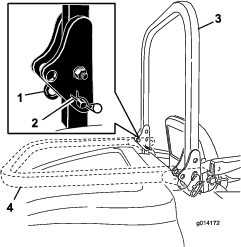
-
Lower the roll bar to the down position (Figure 11).
-
Install the 2 pins and secure them with the hairpin cotter pins (Figure 11).
Important: Ensure that the seat is secured with the seat latch.
-
To raise the roll bar, remove the hairpin cotter pins and remove the 2 pins (Figure 11).
-
Raise the roll bar to the upright position and install the 2 pins and secure them with the hairpin cotter pins (Figure 11).
Important: Always use the seat belt when the roll bar is in the raised and locked position. Do not use the seat belt when the roll bar is in the lowered position.
The Safety Interlock System
Caution
If the safety interlock switches are disconnected or damaged the machine could operate unexpectedly and cause personal injury.
-
Do not tamper with the interlock switches.
-
Check the operation of the interlock switches daily and replace any damaged switches before operating the machine.
Understanding the Safety Interlock System
The safety interlock system is designed to prevent the engine from starting unless:
-
You are sitting on the seat or the parking brake is set.
-
The power takeoff (PTO) is disengaged.
-
The traction pedal is in the NEUTRAL position
-
The engine temperature is below the maximum operating temperature.
The safety interlock system also is designed to shut off the engine when the traction pedal moves from the NEUTRAL position with the parking brake set. If you rise from the seat when the PTO is engaged there is a 1-second delay and then the engine stops.
Testing the Safety Interlock System
Test the safety interlock system before you use the machine each time. If the safety system does not operate as described below, have an Authorized Service Dealer repair the safety system immediately.
-
Sitting on the seat, set the parking brake and move the PTO to the ON position. Try starting the engine; the engine should not start.
-
Sitting on the seat, set the parking brake and move the PTO to the OFF position. Press the traction pedal. Try starting the engine; the engine should not start.
-
Sitting on the seat, set the parking brake, move the PTO switch to the OFF position, and allow the traction pedal to return to the NEUTRAL position. Now start the engine. While the engine is running, release the parking brake, engage the PTO and rise slightly from the seat. On 2-wheel-drive machines, the engine should stop within 2 seconds. On 4-wheel-drive machines, the mower deck will shut off. The engine continues to run.
-
Without an operator on the seat, set the parking brake, move the PTO switch to the OFF position, and move the traction pedal to the NEUTRAL position. Now start the engine. While the engine is running, press the traction pedal; the engine should stop within 2 seconds.
-
Without an operator on the seat, release the parking brake, move the PTO switch to off, and allow the traction pedal to return to the NEUTRAL position. Try starting the engine; the engine should not start.
Selecting the Steering Mode
For maximum trimming and minimum turf damage, operate the machine in the 4-wheel-steering mode. However, when transporting the machine on roads or trails, switch the machine into 2-wheel-steering mode.

Switching from 4-Wheel Steering to 2-Wheel Steering
Press the steering selector switch (Figure 12) to the forward position. When the wheels are not aligned in the forward position, the green light flashes and the machine remains in the 4-wheel-steering mode until the 4 tires point straight ahead. Turn the steering wheel slowly to straighten out the wheels until the green light stops flashing and remains on. When the switch light is solid green, the machine is in 2-wheel steering.
Note: If you turn the steering wheel too briskly, steering misalignment may occur.
Switching from 2-Wheel Steering to 4-Wheel Steering
Press the steering selector switch (Figure 12) to the rearward position. When the front wheels are not aligned in the forward position, the green light flashes and the machine remains in 2-wheel-steering mode until the 4 tires point straight ahead. Turn the steering wheel slowly to straighten out the wheels until the green light stops flashing and remains off. When the switch light is continuously off, the machine is in the 4-wheel-steering mode.
Note: If you turn the steering wheel too briskly, steering misalignment may occur.
Note: If the steering system is misaligned after repeated 2-wheel-steering to 4-wheel-steering engagements, refer to Correcting Steering Misalignment.
Positioning the Standard Seat
Changing the Seat Position
You can move the seat forward and backward. Position the seat where you have the best control of the machine and are most comfortable.
-
Move the lever sideways to unlock the seat (Figure 13).
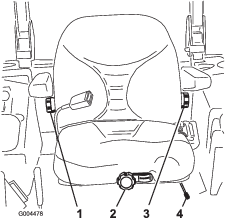
-
Slide the seat to the desired position and release lever to lock it in position.
-
Verify that the seat has locked into place by attempting to move it back and forth.
Changing the Seat Suspension
You can adjust the seat to provide a smooth and comfortable ride. Position the seat where you are most comfortable.
Without sitting on the seat, turn the knob in front either direction to provide the best comfort (Figure 14).
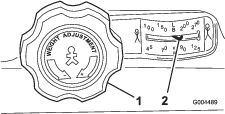
Changing the Back Position
You can adjust the back of the seat to provide a comfortable ride. Position the back of the seat where it is most comfortable.
To adjust it, turn the knob, under the right-side armrest, in either direction to provide the best comfort (Figure 13).
Changing the Lumbar Support
You can adjust the back of the seat to provide a customized lumbar support for your lower back.
To adjust it, turn the knob, under the left-side armrest, in either direction to provide the best comfort (Figure 13).
Positioning the Deluxe Seat
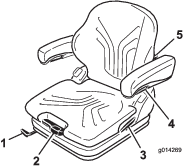
Adjusting the Weight Setting
You can adjust the seat to provide a smooth and comfortable ride.
Important: To adjust the seat for the driver’s weight, the driver must be seated and the ignition key must be in the ON position.
Adjust the seat for your body weight by pulling or pressing the weight-adjustment lever (Figure 15).
The seat is adjusted correctly when the arrow is in the middle clear area of the viewing window.
Within this viewing area, you can adjust the seat to a minimum spring movement.
When the minimum/maximum weight adjustment has been reached, you can hear it reaching the upper- or lower-end stop.
Important: To prevent injury to the operator and/or damage to the machine, check and adjust the weight setting before operating the machine.
Note: To avoid compressor damage during weight adjustment, do not operate the compressor for longer than 1 minute.
Changing the Seat Position
The seat can move forward and backward. Position the seat where you have the best control of the machine and are most comfortable.
-
Lift the lever to unlock the seat (Figure 15).
-
Slide the seat to the desired position and release lever to lock it in position.
-
Verify that the seat has locked into place by attempting to move it back and forth.
Note: Do not operate the locking lever while operating the machine.
Changing the Lumbar Support
The lumbar support increases both the seating comfort and the performance of the driver.
The back of the seat can be adjusted to provide a customized lumbar support for your lower back.
By turning the adjustment knob upwards, the curvature in the upper part of the backrest cushion can be adjusted. By turning the knob downwards, the curvature in the lower part of the backrest cushion can be adjusted (Figure 15).
0 = No curvature
1 = Maximum curvature at the top
2 = Maximum curvature at the bottom
Adjusting the Armrests
You can adjust the height of the armrests and fold them back.
To adjust the height of the armrests, separate the round cap (Figure 15) from the cover, loosen the hexagon nut (13 mm) behind it and adjust the armrests to the desired position and tighten the nut. Then install the cap onto the nut.
Note: Do not install the armrest in the lowest position as the seat-belt roller might not function properly.
Changing the Armrest Angle
You can adjust the angle of the armrests for operator comfort.
To adjust the angle of the armrests, turn the adjustment knob (Figure 15).
Turning the knob to the outside (+) lifts the front part of the armrest; turning the knob to inside (-) lowers it.
Changing the Backrest Position
You can adjust the back of the seat to provide a more comfortable ride. Position the back of the seat where it is most comfortable.
Pull up the locking lever to release the backrest catch (Figure 15). When releasing the backrest catch, do not apply load to the backrest by pressing against it.
By exerting pressure on or off the front or rear of the seat it can be moved to the desired position. Release the locking lever to lock the backrest.
Note: The backrest should not be able to move into another position after it has been locked.
Raising/Lowering the Seat
To access the hydraulic and other systems under the seat, you need to unlatch the seat and swing it forward.
-
Move the seat latch located on the left side of the seat (Figure 16) rearward to unlatch the seat, and pull forward on the top of the seat.
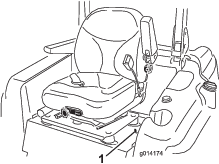
-
To lower the seat, pull up on the seat-latch release bar and lower the seat into the LOCKED position.
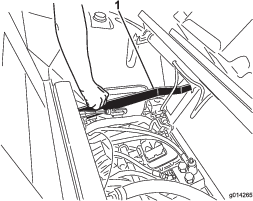
During Operation
During Operation Safety
General Safety
-
The owner/user can prevent and is responsible for accidents that may cause injuries to himself/herself and others and for damage to property.
-
Wear appropriate clothing, including eye protection; slip-resistant, substantial footwear; and hearing protection. Wearing safety shoes and long pants is advisable and required by some local ordinances and insurance regulations. Tie back long hair, secure loose clothing, and do not wear jewelry.
-
Ensure that all drives are in the NEUTRAL position, the parking brake is engaged, and you are in the operating position before you start the engine.
-
Keep all body parts, including hands and feet, away from all moving parts.
-
Do not operate the machine while ill, tired, or under the influence of alcohol or drugs.
-
Keep the direction of the mower discharge away from people and pets.
-
Do not mow in reverse unless it is absolutely necessary. If you must mow in reverse, look behind and down for small children before and while moving the machine in reverse. Stay alert and stop the machine if a child enters the area.
-
Use extreme care when approaching blind corners, shrubs, trees, or other objects that may block your view.
-
Do not mow near drop-offs, ditches, or embankments. The machine could suddenly roll over if a wheel goes over the edge or if the edge caves in.
-
Never carry passengers on the machine.
-
Operate the machine only in good visibility and appropriate weather conditions. Do not operate the machine when there is the risk of lighting.
-
Do not mow on wet grass. Reduced traction could cause the machine to slide.
-
Never raise the mower deck with the blades running.
-
Stop the machine and inspect the blades after striking an object or if there is an abnormal vibration in the machine. Make all necessary repairs before resuming operation.
-
Stop the blades whenever you are not mowing, especially while crossing loose terrain such as gravel.
-
Slow down and use caution when making turns and crossing roads and sidewalks with the machine. Always yield the right-of-way.
-
Turn on the flashing warning lights on the machine whenever you travel on a public road, except where such use is prohibited by law.
-
Disengage the drive to the attachment and shut off the engine before adding fuel and adjusting the height of cut.
-
Reduce the throttle setting before stopping the engine and, if the engine has a fuel-shutoff valve, shut off the fuel when you have finished operating the machine.
-
Never run an engine in an area where exhaust gases are enclosed.
-
Never leave a running engine unattended.
-
Before leaving the operating position, do the following:
-
Stop the machine on level ground.
-
Disengage the power take-off and lower the attachments.
-
Set the parking brake.
-
Shut off the engine and remove the key.
-
Wait for all moving parts to stop.
-
-
Do not change the governor settings on or overspeed the engine. Operating the engine at excessive speed may increase the potential for personal injury.
-
Do not use the machine as a towing vehicle.
-
Use accessories and attachments approved by The Toro® Company only.
Rollover Protection System (ROPS) Safety
-
Do not remove the ROPS from the machine.
-
Ensure that the seat belt is attached and that you can release it quickly in the event of an emergency.
-
Always wear your seat belt when the ROPS is up.
-
Check carefully for overhead clearances, such as branches, doorways, and electrical wires, before driving the machine under them. Do not contact them.
-
Keep the ROPS in safe operating condition by thoroughly inspecting it periodically for damage and keeping all the mounting fasteners tight.
-
Replace a damaged ROPS. Do not repair or revise it.
-
Any alterations to a ROPS must be approved by The Toro® Company.
Slope Safety
-
Slow down the machine and use extra care on hillsides. Travel in the recommended direction on hillsides. Turf conditions can affect the stability of the machine.
-
Avoid starting, stopping, or turning the machine on a slope. If the tires lose traction, disengage the blade(s) and proceed slowly straight down the slope.
-
Do not turn the machine sharply. Use care when reversing the machine.
-
When operating the machine on a slope, always keep all cutting units lowered.
-
Avoid turning the machine on slopes. If you must turn, turn slowly and gradually downhill, if possible.
-
Use extra care while operating the machine with attachments; they can affect the stability of the machine.
Think Safety First
Please read all safety instructions and symbols in the safety section. Knowing this information could help you or bystanders avoid injury.
Caution
This machine produces sound levels in excess of 85 dBA at the operator’s ear and can cause hearing loss through extended periods of exposure.
Wear hearing protection when operating this machine.
The use of protective equipment for eyes, ears, hands, feet, and head is recommended.

Starting and Stopping the Engine
Starting the Engine
-
Raise the roll bar up and lock it into place, sit on the seat, and fasten the seat belt.
-
Make sure that the traction pedal is in the NEUTRAL position.
-
Set the parking brake.
-
Move the PTO (power take-off) switch to the OFF position (Figure 19).
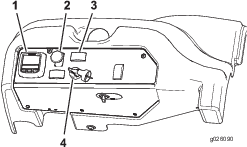
-
Turn the ignition key clockwise to the RUN position.
The InfoCenter glow-plug icon turns on in 6 seconds.
-
After the InfoCenter glow-plug icon goes out, turn the key to the START position. When the engine starts, release the key.
Important: Use starting cycles of no more than 15 seconds per minute to avoid overheating the starter motor.
Note: Additional starting cycles may be required when starting the engine for the first time after the fuel system has been completely drained.
Important: When you start the engine for the first time, or after an engine oil change or an overhaul of the engine, the transmission, or a wheel motor, operate the machine with the engine-speed switch in the Slow position in both the forward and reverse directions for 1 to 2 minutes. Also operate the deck lift switch and the PTO switch to ensure proper operation of all the parts. Then shut the engine off and check the fluid levels and check for oil leaks, loose parts, and any other noticeable malfunctions.
Stopping the Engine
-
Disengage the PTO, make sure that the traction pedal is in the NEUTRAL position, set the parking brake, and move the engine speed switch to the idle position.
-
Let the engine idle for 60 seconds.
-
Turn the ignition key to the OFF position.
-
Remove the key before transporting or storing machine.
Important: Remove the key; otherwise, the fuel pump or accessories may run and cause the battery to lose charge.
Caution
Children or bystanders may be injured if they move or attempt to operate the machine while it is unattended.
Always remove the ignition key and set the parking brake when leaving the machine unattended, even if just for a few minutes.
Driving the Machine
The throttle control regulates the engine speed as measured in rpm (revolutions per minute). Place the throttle control in the Fast position for best performance. Always operate in the Fast throttle position when mowing.
Stopping the Machine
To stop the machine, release the traction pedal to the NEUTRAL position.
Set the parking brake whenever you leave the machine. Remember to remove the key from the ignition switch.
Caution
Children or bystanders may be injured if they move or attempt to operate the machine while it is unattended.
Always remove the ignition key and set the parking brake when leaving the machine unattended, even if just for a few minutes.
Operating the Mower
Raising and Lowering the Mower
The deck lift switch raises and lowers the mower deck (Figure 20). The engine must be running for you to use this switch.
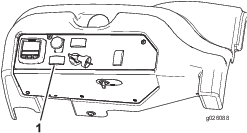
-
To lower the mower deck, push the switch forward.
-
To raise the mover deck, push the switch rearward.
Important: Do not continue to hold the switch back after the mower has fully raised. Doing so will damage the hydraulic system.
Note: To lock the mower deck in a raised position, raise the deck past the 15 cm (6 inch) position, remove the height of cut stop pin, and place the pin in the 15 cm (6 inch) height-of-cut position.
Engaging the Power Takeoff (PTO)
The power-takeoff (PTO) switch starts and stops the mower blades and some powered attachments.
-
If the engine is cold, allow the engine to warm up 5 to 10 minutes before engaging the PTO.
-
While seated in the seat, make sure that the traction pedal is in the Neutral position and the engine is at full throttle.
-
Pull up on the PTO switch to engage it (Figure 21).

Disengaging the PTO
To disengage the PTO, push the switch to the OFF position.
Cutting Grass with the Machine
Note: Cutting grass at a rate that loads the engine promotes DPF regeneration.
-
Move the machine to the job site.
-
Whenever possible, set the engine-speed switch to high idle.
-
Engage the PTO switch.
-
Gradually move the traction pedal forward and slowly drive the machine over the mowing area.
-
Once the front of the cutting units are over the mowing area, lower the cutting units.
-
Cut grass so that the blades can cut and discharge clippings at a high rate while producing a good quality of cut.
Note: If the cutting rate is too high, the quality of cut may deteriorate. Reduce the ground speed of the machine or reduce the width of cut to regain high idle engine speed.
-
When the cutting units are over the far edge of the mowing area, lift the cutting units.
-
Perform a tear-shaped turn to quickly line up for your next pass.
Diesel Particulate Filter Regeneration
The diesel particulate filter (DPF) is part of the exhaust system. The diesel-oxidation catalyst of the DPF reduces harmful gasses and the soot filter removes soot from the engine exhaust.
The DPF regeneration process uses heat from the engine exhaust to incinerate the soot accumulated on the soot filter, converting the soot to ash, and clears the channels of the soot filter so that filtered engine exhaust flows out the DPF.
The engine computer monitors the accumulation of soot by measuring the back pressure in the DPF. If the back pressure is too high, soot is not incinerating in the soot filter through normal engine operation. To keep the DPF clear of soot, remember the following:
-
Passive regeneration occurs continuously while the engine is running—run the engine at full engine speed when possible to promote DPF regeneration.
-
If the back pressure is too high, the engine computer signals you through the InfoCenter when additional processes (assist and reset regeneration) are running.
-
Allow the assist and reset regeneration process to complete before shutting off the engine.
Operate and maintain your machine with the function of the DPF in mind. Engine load at high idle engine speed generally produce adequate exhaust temperature for DPF regeneration.
Important: Minimize the amount of time that you idle the engine or operate the engine at low-engine speed to help reduce the accumulation of soot in the soot filter.
Caution
The exhaust temperature is hot (approximately 600°C (1112°F) during DPF parked regeneration or recovery regeneration. Hot exhaust gas can harm you or other people.
-
Never operate the engine in an enclosed area.
-
Make sure that there are no flammable materials around the exhaust system.
-
Never touch a hot exhaust system component.
-
Never stand near or around the exhaust pipe of the machine.
DPF Soot Accumulation
-
Over time, the DPF accumulates soot in the soot filter. The computer for the engine monitors the soot level in the DPF.
-
When enough soot accumulates, the computer informs you that it is time to regenerate the diesel particulate filter.
-
DPF regeneration is a process that heats the DPF to convert the soot to ash.
-
In addition to the warning messages, the computer reduces the power produced by the engine at different soot-accumulation levels.
| Indication Level | Fault Code | Engine Power Rating | Recommended Action |
| Level 1: Engine Warning |
 | The computer de-rates the engine power to 85% | Perform a parked regeneration as soon as possible; refer to Parked Regeneration. |
| Level 2: Engine Warning |
 | The computer de-rates the engine power to 50% | Perform a recovery regeneration as soon as possible; refer to Recovery Regeneration. |
DPF Ash Accumulation
-
The lighter ash is discharged through the exhaust system; the heavier ash collects in the soot filter.
-
Ash is a residue of the regeneration process. Over time, the diesel particulate filter accumulates ash that does not discharge with the engine exhaust.
-
The computer for the engine calculates the amount of ash accumulated in the DPF.
-
When enough ash accumulates, the engine computer sends information to the InfoCenter in the form of a system advisory or an engine fault to indicate the accumulation of ash in the DPF.
-
The advisory and faults are indications that it is time to service the DPF.
-
In addition to the warnings, the computer reduces the power produced by the engine at different ash-accumulation levels.
| Indication Level | Advisory or Fault Code | Engine Speed Reduction | Engine Power Rating | Recommended Action |
|---|---|---|---|---|
| Level 1: System Advisory |
 | None | 100% | Notify your service department that advisory #179 displays in the InfoCenter. |
| Level 2: Engine Warning |
 | None | The computer de-rates the engine power to 85% | Service the DPF; refer to Servicing the Diesel-Oxidation Catalyst (DOC) and the Soot Filter |
| Level 3: Engine Warning |
 | None | The computer de-rates the engine power to 50% | Service the DPF; refer to Servicing the Diesel-Oxidation Catalyst (DOC) and the Soot Filter |
| Level 4: Engine Warning |
 | Engine speed at max torque + 200 rpm | The computer de-rates the engine power to 50% | Service the DPF; refer to Servicing the Diesel-Oxidation Catalyst (DOC) and the Soot Filter |
Types of Diesel Particulate Filter Regeneration
| Type of Regeneration | Conditions for DPF regeneration | DPF description of operation |
|---|---|---|
| Passive | Occurs during normal operation of the machine at high-engine speed or high-engine load | The InfoCenter does not display an icon indicating passive regeneration. |
| During passive regeneration, the DPF processes high-heat exhaust gasses; oxidizing harmful emissions and burning soot to ash. | ||
| Refer to Passive DPF Regeneration. | ||
| Assist | Occurs as a result of low-engine speed, low-engine load, or after the computer detects back pressure in the DPF | When the assist/reset-regeneration icon  is displayed in the InfoCenter,
an assist regeneration is in progress. is displayed in the InfoCenter,
an assist regeneration is in progress. |
| During assist regeneration, the computer controls the intake throttle to increase the exhaust temperature, enabling assist regeneration to occur. | ||
| Refer to Assist DPF Regeneration. | ||
| Reset | Occurs after assist regeneration only if the computer detects that assist regeneration did not sufficiently reduce the soot level | When the assist/reset-regeneration icon  is displayed in the InfoCenter,
a regeneration is in progress. is displayed in the InfoCenter,
a regeneration is in progress. |
| Also occurs every 100 hours to reset baseline sensor readings | ||
| During reset regeneration, the computer controls the intake throttle and fuel injectors to increase the exhaust temperature during regeneration. | ||
| Refer to Reset Regeneration. |
| Type of Regeneration | Conditions for DPF regeneration | DPF description of operation |
|---|---|---|
| Parked | Soot buildup occurs as a result of prolonged operation at low-engine speed or low-engine load. May also occur as a result of using incorrect fuel or oil | When the parked-regeneration icon  is displayed in the InfoCenter,
a regeneration is requested. is displayed in the InfoCenter,
a regeneration is requested. |
| The computer detects back pressure due to soot buildup and requests a parked regeneration | ||
| • Perform the parked regeneration as soon as possible to avoid needing a recovery regeneration. | ||
| • A parked regeneration requires 30 to 60 minutes to complete. | ||
| • You must have at least a 1/4 tank of fuel in the tank. | ||
| • You must park the machine to perform a recovery regeneration. | ||
| Refer to Parked Regeneration. | ||
| Recovery | Occurs as a result of ignoring parked regeneration requests and continuing operation, adding more soot when the DPF is already in need of a parked regeneration | When the recovery-regeneration icon  is displayed in the InfoCenter,
a recovery regeneration is requested. is displayed in the InfoCenter,
a recovery regeneration is requested. |
| Contact your Authorized Toro Distributor to have a service technician perform the recovery regeneration. | ||
| • A recovery regeneration requires up to 4 hours to complete. | ||
| • You must have at least a 1/2 tank of fuel in the machine. | ||
| • You must park the machine to perform a recovery regeneration. | ||
| Refer to Recovery Regeneration. |
Passive DPF Regeneration
-
Passive regeneration occurs as part of normal engine operation.
-
While operating the machine, run the engine at full-engine speed when possible to promote DPF regeneration.
Assist DPF Regeneration
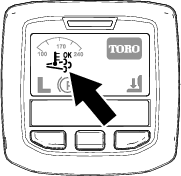
-
The assist/reset-regeneration icon displays in the InfoCenter (Figure 28).
-
The computer takes control of the intake throttle to increase the temperature of the engine exhaust.
-
While operating the machine, run the engine at full engine speed when possible to promote DPF regeneration.
-
The
 icon displays in the InfoCenter while the assist
regeneration is processing.
icon displays in the InfoCenter while the assist
regeneration is processing. -
Whenever possible, do not shut off the engine or reduce engine speed while the assist regeneration is processing.
Important: Allow the machine to complete the assist regeneration process before shutting off the engine.
Note: The assist regeneration is finished processing when the
 icon disappears from the
InfoCenter.
icon disappears from the
InfoCenter.
Reset Regeneration

-
The assist/reset-regeneration icon displays in the InfoCenter (Figure 29).
-
The computer takes control of the intake throttle and changes the fuel injection operation to increase the temperature of the engine exhaust.
Important: The assist/reset-regeneration icon indicates that the exhaust temperature discharged from of your machine may be hotter than during regular operation.
-
While operating the machine, run the engine at full engine speed when possible to promote DPF regeneration.
-
The
 icon displays in the InfoCenter while the reset
regeneration is processing.
icon displays in the InfoCenter while the reset
regeneration is processing. -
Whenever possible, do not shut off the engine or reduce engine speed while the reset regeneration is processing.
Important: Allow the machine to complete the reset regeneration process before shutting off the engine.
Note: The reset regeneration is finished processing when the
 icon disappears from the
InfoCenter.
icon disappears from the
InfoCenter.
Parked Regeneration
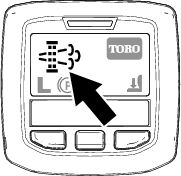
-
The parked-regeneration requested icon displays in the InfoCenter (Figure 30).
-
If a parked regeneration is needed, the InfoCenter displays engine warning SPN 3719, FMI 16 (Figure 31) and the engine computer derates engine power to 85%.

Important: If you do not complete a parked regeneration within 2 hours, the engine computer derates engine power to 50%.
-
A parked regeneration requires 30 to 60 minutes to complete.
-
If you are authorized by your company, you need the PIN code to perform the parked-regeneration process.
Preparing to Perform a Parked or Recovery Regeneration
-
Ensure that the machine has at least 1/4 tank of fuel.
-
Move the machine outside to an area away from combustible materials.
-
Park the machine on a level surface.
-
Ensure that the traction control or motion-control levers are in the NEUTRAL position.
-
If applicable, lower the cutting units and shut them off.
-
Engage the parking brake.
-
Set the throttle to the low IDLE position.
Performing a Parked Regeneration
Note: For instructions on unlocking protected menus, refer to Accessing Protected Menus.
-
Access the protected menu and unlock the protected settings submenu (Figure 32); refer to Accessing Protected Menus.

-
Navigate to the MAIN MENU, press the center button to scroll down to the SERVICE MENU, and press the right button to select the SERVICE option (Figure 33).
Note: The InfoCenter should display the PIN indicator in the upper right corner of the display.
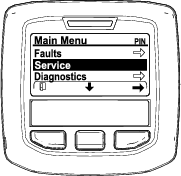
-
In the SERVICE MENU, press the middle button until the DPF REGENERATION options displays, and press the right button to select the DPF REGENERATION option (Figure 34).
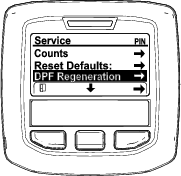
-
When the “Initiate DPF Regen. Are you sure?” message displays, press the center button (Figure 35).
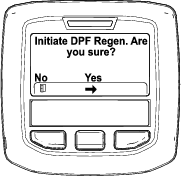
-
If the coolant temperature is below 60°C (140°F) the “Insure
 is running and above 60C/140F” message displays. (Figure 36).
is running and above 60C/140F” message displays. (Figure 36).Observe the temperature in the display, and run the machine at full throttle until the temperature reaches 60°C (140°F), then press the center button.
Note: If the coolant temperature is above 60°C (140°F) this screen is skipped.
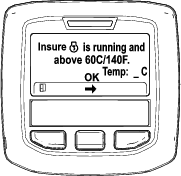
-
Move the throttle control to LOW IDLE and press the center button (Figure 37).
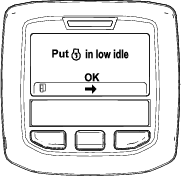
-
The following messages display as the parked regeneration process begins:
-
The “Initiating DPF Regen.” message displays (Figure 38).
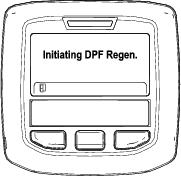
-
The “Waiting on
 ” message displays
(Figure 39).
” message displays
(Figure 39).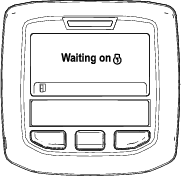
-
The computer determines whether the regeneration runs. One of the following messages displays in the InfoCenter:
-
If the regeneration is allowed, the “Regen Initiated. Allow up to 30 minutes for completion” message displays in the InfoCenter, wait for the machine to complete the parked regeneration process (Figure 40).
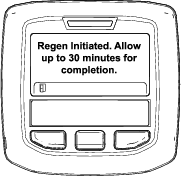
-
If the regeneration process is not allowed by the engine computer, the “DPF Regen Not Allowed” message displays in the InfoCenter (Figure 41). Press the left button to exit to the home screen
Important: If you did not meet all the requirements for regeneration or if less than 50 hours have passed since the last regeneration, the “DPF Regen Not Allowed” message appears.
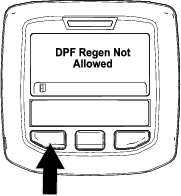
-
-
-
While the regeneration is running, the InfoCenter returns to the home screen and shows the following icons:

The engine is cold—wait. 
The engine is warm—wait. 
The engine hot—regeneration in progress (percent complete). -
The parked regeneration is complete when the “Regen Complete” message displays in the InfoCenter. Press the left button to exit to the home screen (Figure 42).
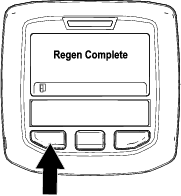
Recovery Regeneration
-
If you ignore the request for a parked regeneration (displayed in the InfoCenter) and continue to operate the machine, a critical amount of soot builds up in the DPF.
-
If a recovery regeneration is needed, the InfoCenter displays engine warning SPN 3719, FMI 16 (Figure 43) and the engine computer derates engine power to 85%.

Important: If you do not complete a recovery regeneration within 15 minutes, the engine computer derates engine power to 50%.
-
Perform a recovery-regeneration whenever there is a loss of engine power and a parked regeneration cannot effectively clean the DPF of soot.
-
A recovery regeneration requires up to 4 hours to complete.
-
You need a distributor technician to perform the recovery regeneration process; contact your Authorized Toro Distributor.
Operating Tips
Using the Fast Throttle Setting
To maintain enough power for the machine and deck while mowing, operate the engine at the fast throttle position and adjust your ground speed for conditions.
Selecting the Ground Speed
To improve cut quality, use a slower ground speed. Decrease the ground speed as the load on the cutting blades increases, and increase ground speed as load on the blades decreases.
Alternating Mowing Direction
Alternate mowing direction to avoid making ruts in the turf over time. This also helps disperse clippings which enhances decomposition and fertilization.
Avoiding Cutting Too Low
If the cutting width of the mower is wider than the mower you previously used, raise the cutting height to ensure that uneven turf is not cut too short.
Selecting the Proper Height of Cut to Suit Conditions
Remove approximately 25 mm (1 inch) or no more than 1/3 of the grass blade when cutting. In exceptionally lush and dense grass, you may have to slow down the forward speed and/or raise the height of cut to the next higher setting.
Important: If cutting more than 1/3 of the grass blade off, or in sparse long grass or dry conditions, the use of flat sail blades is recommended to reduce air-borne chaff, debris, and unnecessary strain on deck-drive components.
Cutting Long Grass
If the grass is ever allowed to grow slightly longer than normal, or if it contains a high degree of moisture, raise the cutting height higher than usual and cut the grass at this setting. Then cut the grass again using the lower, normal setting.
Keeping the Mower Clean
Clean clippings and dirt from the underside of the mower after each use. If grass and dirt build up inside the mower, cutting quality will eventually become unsatisfactory.
To reduce the risk of fire, keep the engine, muffler, battery compartment, parking brake, cutting units, and fuel storage compartment free of grass, leaves, or excessive grease. Clean up any spilled oil or fuel.
Maintaining the Blades
Maintain sharp blades throughout the cutting season because sharp blades cut cleanly without tearing or shredding the grass blades. Tearing and shredding turns grass brown at the edges, which slows growth and increases the chance of disease. Check the blades daily for sharpness and for any wear or damage. Sharpen the blades as necessary. If a blade is damaged or worn, replace it immediately with a genuine Toro replacement blade. Refer to Servicing the Cutting Blades in the mower-deck manual.
After Operation
After Operation Safety
General Safety
-
Clean grass and debris from the cutting units, drives, mufflers, and engine to help prevent fires. Clean up oil or fuel spills.
-
Shut off the fuel while storing or transporting the machine, if applicable.
-
Disengage the drive to the attachment whenever you are transporting or not using the machine.
-
Allow the engine to cool before storing the machine in any enclosure.
-
Never store the machine or fuel container where there is an open flame, spark, or pilot light, such as on a water heater or on other appliances.
Pushing the Machine by Hand
If the machine runs out of fuel or stalls for another reason, you may need to push it. To do so, you first need to open both of the hydraulic bypass valves.
Important: Always push the machine by hand and never over a long distance. Never tow the machine, because hydraulic damage may occur.
Pushing the Machine
-
Disengage the power take-off (PTO), turn the ignition key to the OFF position and apply the parking brake.
-
Remove the key from the ignition switch.
-
Lift the seat.
-
Rotate each bypass valve counterclockwise 1 turn (Figure 44).
Both bypass valves must be open. This allows the hydraulic fluid to bypass the pump, enabling the wheels to turn.
Important: Do not rotate the bypass valves more than 1 turn. This prevents the valves from coming out of the body and causing fluid to run out.
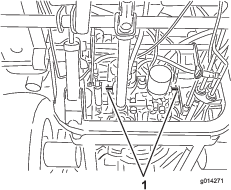
-
Release the parking brake before pushing the machine.
Changing to Machine Operation
Rotate each bypass valve clockwise 1 turn and hand tighten them. Torque them to approximately 8 N∙m (71 in-lb); refer to Figure 44.
Note: The machine does not drive unless the bypass valves are tightened. Do not overtighten the bypass valves.
Hauling the Machine
-
Use care when loading or unloading the machine into a trailer or a truck.
-
Use full-width ramps for loading the machine into a trailer or a truck.
-
Tie the machine down securely using straps, chains, cable, or ropes. Both front and rear straps should be directed down and outward from the machine.

Maintenance
Note: Determine the left and right sides of the machine from the normal operating position.
Recommended Maintenance Schedule(s)
| Maintenance Service Interval | Maintenance Procedure |
|---|---|
| After the first 10 hours |
|
| After the first 200 hours |
|
| Before each use or daily |
|
| Every 50 hours |
|
| Every 100 hours |
|
| Every 200 hours |
|
| Every 250 hours |
|
| Every 400 hours |
|
| Every 800 hours |
|
| Every 1,500 hours |
|
| Every 6,000 hours |
|
| Every 2 years |
|
Important: Refer to your engine operator's manual for additional maintenance procedures. A detailed service manual is also available for purchase from your Authorized Toro Distributor.
Note: To obtain an electrical schematic or a hydraulic schematic for your machine, visit www.Toro.com.
Pre-Maintenance Procedures
Pre-Maintenance Safety
-
Keep all parts of the machine in good working condition and all hardware tightened, especially blade-attachment hardware. Replace all worn or damaged decals.
-
Never allow untrained personnel to service the machine.
-
Before adjusting, cleaning, or repairing the machine, do the following:
-
Move the machine to level ground.
-
Disengage the drives.
-
Lower the cutting units.
-
Move the traction pedal to the NEUTRAL position.
-
Engage the parking brake.
-
Move the throttle switch to the LOW-IDLE position.
-
Shut off the engine and remove the key.
-
Wait for all moving parts to stop.
-
-
Whenever you park or store the machine, or leave it unattended, lower the cutting units unless you use a positive mechanical lock.
-
If possible, do not perform maintenance on the machine while the engine is running. If you must run the engine to perform maintenance on the machine, keep your hands, feet, other body parts, and clothing away from all moving parts, the mower-discharge area, and the underside of the mowers.
-
Do not touch parts of the machine or an attachment that may be hot from operation. Allow the parts to cool before attempting to maintain, adjust, or service them.
-
Use jack stands to support the machine and/or its components when required.
-
Carefully release pressure from components with stored energy.
-
If your machine requires major repairs or if you desire assistance, contact an Authorized Toro Distributor.
-
Use only genuine Toro replacement parts and accessories. Replacement parts and accessories made by other manufacturers could be dangerous, and such use could void the product warranty.
Preparing the Machine for Maintenance
-
Ensure that the PTO is disengaged.
-
Park the machine on a level surface.
-
Set the parking brake.
-
Lower the mower deck(s) if necessary.
-
Shut off the engine and wait for all moving parts to stop.
-
Turn the ignition key to the STOP position and remove it.
-
Allow machine components to cool before performing maintenance.
Using the Hood Prop Rod
-
Release the hood latches.
-
Raise the hood high enough to position the prop rod behind the frame tube (Figure 47).
-
Lower the hood until the rod is in front of and resting against the frame tube.
-
To lower the hood, raise the hood until the prop rod can be raised above the frame tube, then lower the hood.
-
Secure the hood latches.

Lubrication
Greasing the Bearings and Bushings
| Maintenance Service Interval | Maintenance Procedure |
|---|---|
| Before each use or daily |
|
| Every 50 hours |
|
The machine has grease fittings that you must lubricate regularly with No. 2 lithium grease. Also, lubricate the machine immediately after every washing.
-
Wipe the grease fittings clean so that foreign matter is not forced into the bearing or bushing.
-
Pump grease into the fittings.
-
Wipe off any excess grease.
Note: To access the grease fittings of the rear steering linkage, remove the storage compartment.
Note: Jack the machine off the floor to allow better grease migration through both the upper and lower kingpin bushings. Grease must be observed purging out of both the top and the bottom of the axle casting/bushing assembly areas of all 4 kingpin assemblies.
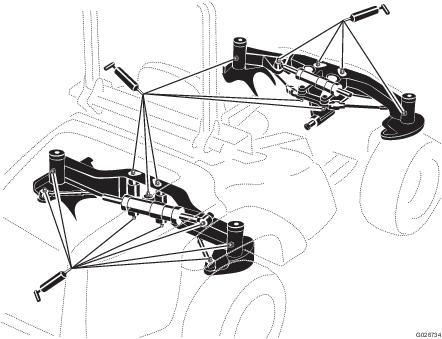
Note: Bearing life can be negatively affected by improper washing procedures. Do not wash the machine when it is still hot, and avoid directing high-pressure or high-volume spray at the bearings or seals.
Engine Maintenance
Servicing the Air Cleaner
| Maintenance Service Interval | Maintenance Procedure |
|---|---|
| Before each use or daily |
|
| Every 400 hours |
|
Check the air-cleaner body for damage, which could cause an air leak. Replace it if it is damaged. Check the whole intake system for leaks, damage, or loose hose clamps.
Service the air-cleaner filter only when the service indicator requires it (Figure 49). Changing the air filter before it is necessary only increases the chance of dirt entering the engine when you remove the filter.
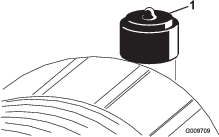
Important: Be sure that the cover is seated correctly and seals with the air-cleaner body.
-
Replace the air cleaner (Figure 50).
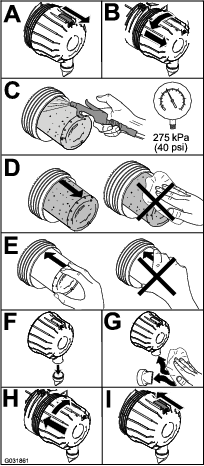
Note: Do not clean the used element due to the possibility of damage to the filter media.
Important: Never attempt to clean the safety filter (Figure 51). Replace the safety filter after every 3 primary filter services.
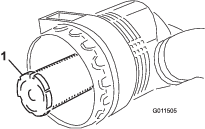
-
Reset the indicator (Figure 49) if it shows red.
Servicing the Engine Oil
Oil Specification
Use high-quality, low-ash engine oil that meets or exceeds the following specifications:
-
API service category CJ-4 or higher
-
ACEA service category E6
-
JASO service category DH-2
Important: Using engine oil other than API CJ-4 or higher, ACEA E6, or JASO DH-2 may cause the diesel particulate filter to plug or cause engine damage.
Use the following engine oil viscosity grade:
-
Preferred oil: SAE 15W-40 (above 0°F)
-
Alternate oil: SAE 10W-30 or 5W-30 (all temperatures)
Toro Premium Engine Oil is available from your Authorized Toro Distributor in either 15W-40 or 10W-30 viscosity grades. See the parts catalog for part numbers.
Checking the Engine-Oil Level
| Maintenance Service Interval | Maintenance Procedure |
|---|---|
| Before each use or daily |
|
The engine is shipped with oil in the crankcase; however, the oil level must be checked before and after the engine is first started.
Important: Check the engine oil daily. If the engine-oil level is above the Full mark on the dipstick, the engine oil may be diluted with fuel;If the engine oil level is above the Full mark, change the engine oil.
The best time to check the engine oil is when the engine is cool before it has been started for the day. If it has already been run, allow the oil to drain back down to the sump for at least 10 minutes before checking. If the oil level is at or below the Add mark on the dipstick, add oil to bring the oil level to the Full mark. Do not overfill the engine with oil.
Important: Keep the engine oil level between the upper and lower limits on the dipstick; the engine may fail if you run it with too much or too little oil.
-
Park the machine on a level surface.
-
Remove the dipstick, wipe it clean, install the dipstick into the tube, and pull it out again. The oil level should be between the full and add marks (Figure 52).
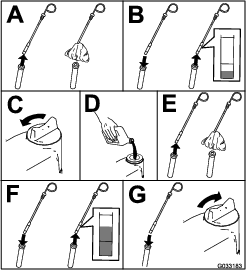
Crankcase Oil Capacity
Approximately 5.7 L (6 US qt) with the filter.
Changing the Engine Oil and Filter
| Maintenance Service Interval | Maintenance Procedure |
|---|---|
| Every 250 hours |
|
-
Start the engine and let it run 5 minutes to allow the oil to warm up.
-
Park the machine on a level surface, shut off the engine, remove the key, and wait for all moving parts to stop before leaving the operating position.
-
Replace the engine oil and filter (Figure 53).
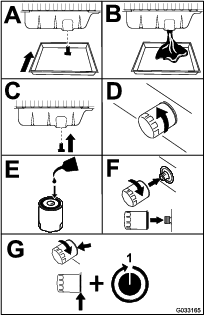
-
Add oil to the crankcase; refer to Checking the Engine-Oil Level.
Servicing the Diesel-Oxidation Catalyst (DOC) and the Soot Filter
| Maintenance Service Interval | Maintenance Procedure |
|---|---|
| Every 6,000 hours |
|
-
If advisory message displays in the InfoCenter, the DPF is nearing the recommended point for servicing the diesel-oxidation catalyst and the soot filter.

-
If engine faults , , or in the InfoCenter (Figure 55) display in the InfoCenter, clean the soot filter using the steps that follow:



-
Refer to the Engine section in the Service Manual for information on disassembling and assembling the diesel-oxidation catalyst and the soot filter of the DPF.
-
Refer to your Authorized Toro Distributor for diesel-oxidation catalyst and the soot filter replacement parts or service.
-
Contact your Authorized Toro Distributor to have them reset the engine ECU after you install a clean DPF.
-
Fuel System Maintenance
Note: Refer to Fuel Specification for the proper fuel recommendations.
Servicing the Water Separator
| Maintenance Service Interval | Maintenance Procedure |
|---|---|
| Before each use or daily |
|
| Every 400 hours |
|
Service the water separator as shown in Figure 56.
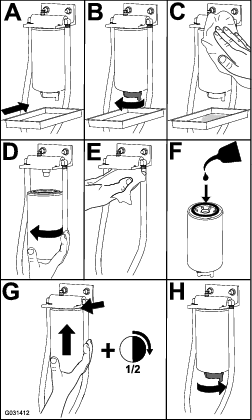
Servicing the Engine Fuel Filter
| Maintenance Service Interval | Maintenance Procedure |
|---|---|
| Every 400 hours |
|
-
Clean the area around the filter head (Figure 57).
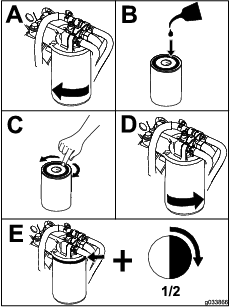
-
Start the engine and check for fuel leaks around the filter head.
Checking the Fuel Lines and Connections
| Maintenance Service Interval | Maintenance Procedure |
|---|---|
| Every 400 hours |
|
Inspect the fuel lines and connections for deterioration, damage, or loose connections.
Cleaning the Fuel Pick-Up Tube Screen
The fuel pick-up tube, located inside the fuel tank, is equipped with a screen to help prevent debris from entering the fuel system. Remove the fuel pick-up tube and clean the screen as required.
Electrical System Maintenance
Important: Whenever working with the electrical system, always disconnect the battery cables, negative (-) cable first, to prevent possible wiring damage from short-outs.
Electrical System Safety
-
Disconnect the battery before repairing the machine. Disconnect the negative terminal first and the positive last. Connect the positive terminal first and the negative last.
-
Battery acid is poisonous and can cause burns. Avoid contact with your skin, eyes, and clothing. Protect your face, eyes, and clothing when working with a battery.
-
Battery gases can explode. Keep cigarettes, sparks, and flames away from the battery.
-
Charge the batteries in an open, well-ventilated area, away from sparks and flames. Unplug the charger before connecting or disconnecting the battery. Wear protective clothing and use insulated tools.
-
Do not use a pressure washer near any electronic components.
Warning
Battery posts, terminals, and related accessories contain lead and lead compounds, chemicals known to the State of California to cause cancer and reproductive harm. Wash hands after handling.
Checking the Fuses
If the machine stops or has other electrical system issues, check the fuses. Grasp each fuse in turn and remove them 1 at a time, checking to see if any are blown. If you need to replace a fuse, always use the same type and amperage rated fuse as the one you are replacing, otherwise you could damage the electrical system (refer to the decal next to the fuses for a diagram of each fuse and its amperage).
The fuses are located under the seat (Figure 58).
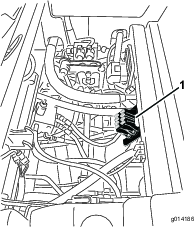
Servicing the Battery
| Maintenance Service Interval | Maintenance Procedure |
|---|---|
| Every 50 hours |
|
Keep the top of the battery clean. If you store the machine in a location where temperatures are extremely high, the battery will run down more rapidly than if the machine is stored in a location where temperatures are cool.
Keep the top of the battery clean by washing it periodically with a brush dipped in ammonia or baking-soda solution. Flush the top surface with water after cleaning it. Do not remove the fill caps while cleaning the battery.
The battery cables must be tight on the terminals to provide good electrical contact.
If corrosion occurs at the terminals, disconnect the cables, negative (-) cable first, and scrape the clamps and terminals separately. Connect the cables, positive (+) cable first, and coat the terminals with petroleum jelly.
Warning
Battery terminals or metal tools could short against metal machine components, causing sparks. Sparks can cause the battery gasses to explode, resulting in personal injury.
-
When removing or installing the battery, do not allow the battery terminals to touch any metal parts of the machine.
-
Do not allow metal tools to short between the battery terminals and metal parts of the machine.
Warning
Incorrect battery cable routing could damage the machine and cables causing sparks. Sparks can cause the battery gasses to explode, resulting in personal injury.
-
Always disconnect the negative (black) battery cable before disconnecting the positive (red) cable.
-
Always connect the positive (red) battery cable before connecting the negative (black) cable.
Storing the Battery
If the machine will be stored more than 30 days, remove the battery and charge it fully. Either store it on a shelf or on the machine. Leave the cables disconnected if it is stored on the machine. Store the battery in a cool atmosphere to avoid quick deterioration of the charge in the battery. To prevent the battery from freezing, make sure that it is fully charged. The specific gravity of a fully charged battery is 1.265 to 1.299.
Drive System Maintenance
Checking the Tire Pressure
| Maintenance Service Interval | Maintenance Procedure |
|---|---|
| Every 50 hours |
|
Check the pressure after every 50 operating hours or monthly, whichever occurs first.
Maintain the air pressure in the front and rear tires. The correct air pressure is 172 kPa (25 psi) in the rear tires and 103 kPa (15 psi) in the front tires. If a cab is installed on the machine, the front and rear tires should be inflated to 172 kPa (25 psi). Uneven tire pressure can cause uneven cut. To get the most accurate pressure reading, check the tires when they are cold.
Correcting Steering Misalignment
-
Press the steering selector switch to the rearward 4-wheel-steer position (Figure 59).

-
On a paved or dirt surface, turn the steering wheel to the left or right and continue turning until all 4 wheels have stopped turning. Automatic synchronization of wheel alignment should occur.
Important: Doing this procedure on turf can result in turf damage directly under each of the turning tires.
Cooling System Maintenance
Cooling System Safety
Caution
Discharge of hot, pressurized coolant or touching a hot radiator and surrounding parts can cause severe burns.
-
Do not remove the radiator cap when the engine is hot. Always allow the engine to cool at least 15 minutes or until the radiator cap is cool enough to touch without burning your hand before removing the radiator cap.
-
Do not touch the radiator and surrounding parts that are hot.
Danger
Swallowing engine coolant can cause poisoning.
-
Do not swallow engine coolant.
-
Keep out of reach from children and pets.
Checking the Cooling System
| Maintenance Service Interval | Maintenance Procedure |
|---|---|
| Before each use or daily |
|
The cooling system is filled with a 50/50 solution of water and permanent ethylene-glycol antifreeze. Check the level of the coolant in the expansion tank at the beginning of each day before starting the engine. The capacity of the cooling system is 7.5 L (6 US qt).
-
Check the level of the coolant in the expansion tank (Figure 60). The coolant level should be between the marks on the side of the tank.
-
If the coolant level is low, remove the expansion-tank cap and replenish the system. Do not overfill the cooling system.
-
Install the cap of the expansion tank.
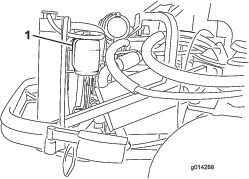
Cleaning the Radiator
| Maintenance Service Interval | Maintenance Procedure |
|---|---|
| Before each use or daily |
|
| Every 200 hours |
|
| Every 1,500 hours |
|
| Every 2 years |
|
To prevent the engine from overheating, keep the radiator clean. Normally, check the radiator daily and, if necessary, clean any debris off these parts. Check and clean the radiator frequently in extremely dusty and dirty conditions.
Note: If the mower deck or engine shuts off due to overheating, first check the radiator for excessive buildup of debris.
Clean the radiator as follows:
-
Open the hood and secure the prop rod.
-
Loosen the flange nut securing the clean-out cover to the underside of the rear frame (Figure 61). Rotate the cover to the side to expose the clean-out hole in the frame.
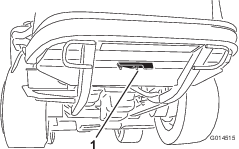
-
Working from the fan side of the radiator, blow out debris with low-pressure (345 kPa [50 psi]) compressed air (do not use water). Repeat the step from the front of the radiator and again from the fan side.
-
After the radiator is thoroughly cleaned, clean out any debris that may have collected in the channel at the radiator base and around the frame. Also, clean out the engine compartment and the brake linkage to ensure optimum performance.
-
Close the clean-out cover and secure the flange nut.
-
Close the hood.
Brake Maintenance
Adjusting the Service Brakes
Adjust the service brakes when there is more than 25 mm (1 inch) of free travel of the brake pedal, or when the brakes do not work effectively. Free travel is the distance the brake pedal moves before you feel braking resistance.
Note: Use the wheel motor backlash to rock the drums back and forth to ensure that the drums are free prior to and after adjustment.
-
To reduce free travel of the brake pedals, tighten the brakes by loosening the front nut on the threaded end of the brake cable (Figure 62).

-
Tighten the rear nut to move the cable backward until the brake pedals have 1.27 to 1.9 cm (1/2 to 3/4 inch) of free travel, before wheel lockup is achieved.
-
Tighten the front nuts, ensuring that both cables actuate the brakes simultaneously.
Adjusting the Parking Brake
If the parking brake fails to engage, an adjustment to the brake pawl is required.
-
Loosen the 2 screws securing the parking-brake pawl to the frame (Figure 63).
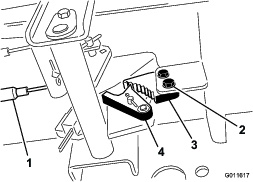
-
Press the parking-brake pedal forward until the brake detent completely engages on the brake pawl (Figure 63).
-
Tighten the 2 screws to lock the adjustment.
-
Press the brake pedal to release the parking brake.
-
Check the adjustment and adjust it again as required.
Belt Maintenance
Checking the Alternator Belt
| Maintenance Service Interval | Maintenance Procedure |
|---|---|
| After the first 10 hours |
|
| Every 100 hours |
|
Check the condition and tension of the belt (Figure 64) after every 100 operating hours.
-
Proper tension will allow 10 mm (3/8 inch) deflection when a force of 44 N (10 lb) is applied on the belt midway between the pulleys.
-
If the deflection is not 10 mm (3/8 inch), loosen the alternator mounting bolts (Figure 64). Increase or decrease the tension of the alternator belt and tighten the bolts. Check the deflection of the belt again to ensure that the tension is correct.
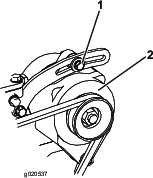
Controls System Maintenance
Adjusting the Traction Drive for Neutral
Note: If the machine has recently had the hydraulic fluid changed or the traction motors or hoses replaced, any air trapped in the system will have to be worked out prior to performing this procedure. This can be accomplished by operating the machine in forward and reverse for a few minutes and then replenishing the oil as required.
Note: When positioned on a level surface, the machine must not creep when the traction pedal is released.
-
Park the machine on a level surface, shut off the engone, and lower the cutting unit to the floor.
-
Jack up the rear of the machine until the rear tires are off the shop floor. Support the machine with jack stands to prevent it from falling accidentally.
Note: On 4-wheel-drive models, the front tires must also be off the shop floor and supported by jack stands.
Warning
The engine must be running so that this adjustment can be performed. This could cause personal injury.
Keep hands, feet, face, and other body parts away from any hot parts of the engine and any rotating parts.
-
Start the engine, set the throttle to the Slow position, and observe which direction the rear tires rotate.
Important: Make sure that the traction pedal is in the NEUTRAL position.
-
If the left rear tire is rotating, loosen the jam nuts on the left side transmission control rod (Figure 65).
Note: The forward end of the control rod has a left-hand thread. The rear end of the rod, which is connected to the transmission, has a right-hand thread.
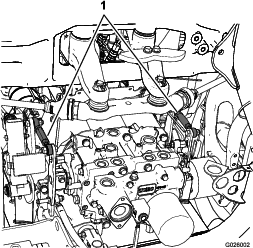
-
If the left rear tire is rotating in reverse, lengthen the rod by slowly turning the rod counterclockwise (as viewed from the front) until the left rear tire stops rotating or has minimal rotation in reverse.
-
If the left rear tire is rotating forward, shorten the rod by slowly turning the rod clockwise (as viewed from the front) until the left rear tire stops rotating.
-
-
Move the throttle to the Fast position. Make sure that the wheel remains stopped or has minimal rotation in reverse. Adjust it as required.
-
Tighten the jam nuts.
-
Repeat the procedure for the right rear tire, if required, by using the right-side transmission control rod.
-
Stop the engine. Remove the jack stands and lower the machine to the shop floor.
-
Test drive the machine to make sure that it does not creep.
Adjusting the Maximum Ground Speed
-
Disengage the PTO, release the traction pedal to the NEUTRAL position, and set the parking brake.
-
Move the throttle lever to the Slow position, shut off the engine, remove the key, and wait for all moving parts to stop before leaving the operating position.
-
Loosen the jam nut on the stop bolt for the traction pedal (Figure 66).
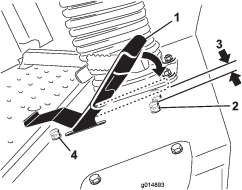
-
Adjust the stop bolt all the way inward (away from the traction pedal).
-
Push the traction pedal with your hand all the way forward with light pressure until it stops, and hold it there. Maintain only light pressure on the pedal when pushing it to the full forward position.
-
With the seat in the raised position, verify that you are not overloading the linkage by making sure that the transmission does not move when you press the pedal to the stop.
-
Adjust the stop bolt outward (toward the traction pedal) until there is a gap of 1.5 mm (0.060 inch) between the head of the stop bolt and the bottom of the traction pedal.
-
Tighten the jam nut to secure the stop bolt in place.
-
Adjust the reverse stop bolt if the maximum reverse speed is not acceptable.
Note: For a faster reverse speed, adjust the stop bolt inward. For a slower reverse speed, adjust the stop bolt outward.
Adjusting the Mow-Speed Limiter
Flip the mow-speed limiter (Figure 67) forward to limit the traction speed of the machine.
-
Disengage the PTO, release the traction pedal to the NEUTRAL position, and set the parking brake.
-
Move the throttle lever to the Slow position, shut off the engine, remove the key, and wait for all moving parts to stop before leaving the operating position.
-
Loosen the jam nut on the stop bolt of the mow-speed limiter (Figure 67).
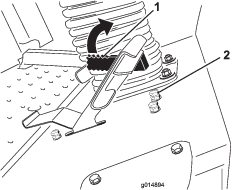
-
Thread the stop bolt in to increase the mow speed and out to decrease the mow speed.
-
Tighten the jam nut to lock the adjustment.
-
Rotate the mow-speed limiter down, operate the machine to verify the adjustment, and adjust the stop bolt again if required.
Hydraulic System Maintenance
Hydraulic System Safety
Warning
Hydraulic fluid escaping under pressure can penetrate skin and cause injury.
-
Ensure that all hydraulic-fluid hoses and lines are in good condition and all hydraulic connections and fittings are tight before applying pressure to the hydraulic system.
-
Keep your body and hands away from pinhole leaks or nozzles that eject high-pressure hydraulic fluid.
-
Use cardboard or paper to find hydraulic leaks.
-
Safely relieve all pressure in the hydraulic system before performing any work on the hydraulic system.
-
Seek immediate medical attention if fluid is injected into skin.
Checking the Hydraulic System
| Maintenance Service Interval | Maintenance Procedure |
|---|---|
| Before each use or daily |
|
The reservoir is filled at the factory with approximately 17 L (18 US qt) of high-quality tractor transmission/hydraulic fluid. The recommended replacement fluid is as follows:
Toro Premium All Season Hydraulic Fluid (Available in 19 L (5 gallon) pails or 208 L (55 gallon) drums. See the Parts Catalog or your Toro Distributor for part numbers).
Alternate fluids: If the Toro fluid is not available, Mobil® 424 hydraulic fluid may be used.
Note: Toro will not assume responsibility for damage caused by improper substitutions.
Note: Many hydraulic fluids are almost colorless, making it difficult to spot leaks. A red dye additive for the hydraulic system oil is available in 20 ml (2/3 fl oz) bottles. One bottle is sufficient for 15 to 22 L (4 to 6 US gallons) of hydraulic fluid. Order part number 44-2500 from your authorized Toro distributor.
-
Position the machine on a level surface. Release the traction pedal to the NEUTRAL position and start the engine. Run the engine at the lowest possible speed to purge the system of air. Do not engage the PTO. Raise the deck to extend the lift cylinders, shut off the engine, and remove the key.
-
Remove the hydraulic-fill cap (Figure 68) from the filler neck.
-
Remove the dipstick and wipe it with a clean rag (Figure 68).
-
Screw the dipstick all the way into the filler neck; then remove it, and check the level of the fluid (Figure 68).
If the level is not within the notched area of the dipstick, add enough high-quality hydraulic fluid to raise the level to within the notched area. Do not overfill the hydraulic system.
-
Replace the dipstick and thread the fill cap finger-tight onto the filler neck.
-
Check all hoses and fittings for leaks.
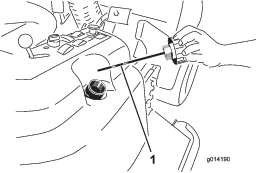
Changing the Hydraulic Fluid And Filter
| Maintenance Service Interval | Maintenance Procedure |
|---|---|
| After the first 200 hours |
|
| Every 800 hours |
|
-
Disengage the PTO, release the traction pedal to the NEUTRAL position and set the parking brake.
-
Move the throttle lever to the SLOW position, shut off the engine, remove the key, and wait for all moving parts to stop before leaving the operating position.
-
Place a large pan under the hydraulic reservoir and transmission case and remove the plugs, draining all of the hydraulic fluid (Figure 69).
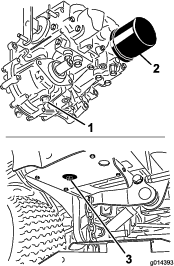
-
Clean the area around the hydraulic-fluid filter and remove the filter (Figure 69).
-
Immediately install a new hydraulic-fluid filter.
-
Install the drain plugs in the hydraulic reservoir and the transmission case.
-
Fill the reservoir to the proper level; refer to Checking the Hydraulic System.
-
Start the engine and check for fluid leaks. Allow the engine to run for about 5 minutes, then shut it off.
-
After 2 minutes, check the level of the hydraulic fluid; refer to Checking the Hydraulic System.
Cleaning
Waste Disposal
Engine oil, batteries, hydraulic fluid, and engine coolant are pollutants to the environment. Dispose of these according to your state and local regulations.
Storage
Preparing the Engine
-
Drain the engine oil from the oil pan and install the drain plug.
-
Remove and discard the oil filter. Install a new filter.
-
Fill the engine with the designated quantity of engine oil. Refer to Checking the Engine-Oil Level.
-
Start the engine and run it at idle speed for 2 minutes.
-
Drain the fuel from the fuel tank, fuel lines, pump, filter, and separator. Flush the fuel tank with clean diesel fuel and connect all fuel lines.
-
Thoroughly clean and service the air-cleaner assembly.
-
Seal the air-cleaner inlet and the exhaust outlet with weatherproof masking tape.
-
Check the oil-filler cap and fuel-tank cap to ensure that they are securely in place.
Preparing the Machine
-
Thoroughly clean the machine, the deck, and the engine, paying special attention to the following areas:
-
Radiator and radiator screen
-
Counterbalance springs
-
PTO-shaft assembly
-
All grease fittings and pivot points
-
Inside of the control box (Remove the control panel for access.)
-
Beneath the seat plate and the top of the transmission
-
-
Check and adjust the tire pressure; refer to Checking the Tire Pressure.
-
Check all fasteners for looseness and tighten them as necessary.
-
Grease or oil all grease fittings, pivot points, and transmission bypass-valve pins. Wipe off any excess lubricant.
-
Lightly sand and use touch-up paint on painted areas that are scratched, chipped, or rusted. Repair any dents in the metal body.
-
Service the battery and cables as follows:
-
Remove the battery terminals from the battery posts.
-
Clean the battery, terminals, and posts with a wire brush and baking-soda solution.
-
Coat the cable terminals and battery posts with Grafo 112X skin-over grease (Toro Part No. 505-47) or petroleum jelly to prevent corrosion.
-
Slowly charge the battery for 24 hours every 60 days to prevent lead sulfation of the battery.
-